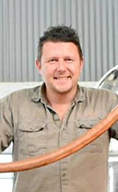
By Hendre’ Barnard, Training and Marketing Manager
Distillique Beverage (Pty) Ltd.
https://distillique.co.za
Water quality matters
So can you build the perfect fermentation water? Not to the extent that some bottled brands would have you believe in their advertising, but it can have a large impact on yeast health, and hence on fermentation success.
Recently, several of our clients have had trouble with water quality. This has often been the result of excess minerals or iron, especially in borehole water, or the result of excessive chlorine in municipal tap water.
An Alternative to Standard Water Sources
One proposed alternative is reverse osmosis water. Many distillers, especially those operating commercially, have access to reverse osmosis water, and it contains almost no dissolved substances. Unfortunately, this is a double-edged sword. Reverse osmosis contains no stress-inducing compounds, but it also contains nothing else. As such, it lacks important minerals that yeast require for healthy fermentation.
To solve this problem, we developed a packet of minerals that can be dissolved in reverse osmosis water. It contains the ideal balance of minerals for optimum hardness and necessary supplementation. Keep in mind that only key minerals are included. Other yeast nutritive needs, such as vitamins and nitrogen, will still need to be met by the addition of yeast nutrients as usual.
Testing of the Remineralization Pack
In order to validate our mineral mixture, we conducted a simple experiment. Two sets of brown sugar washes were set up. As many variables as possible were controlled (kept the same). The same quantity of sugar was used for both sets, 24° Brix. The same amount of yeast was used in both sets, and they were both supplemented with the same quantity of nutrients. Only the water type was changed. In one set, our municipal tap water was used. In the other, reverse osmosis water was used, supplemented with our mineral packet. The fermentations were all carried out at room temperature.
NOTE: We have not had any problems with our municipal tap water in the past, but we wanted to test the effectiveness of the mixture with RO water against a known water source.
The fermentations were monitored for several days. Initially, their rates of fermentation were fairly close. By day 3, the tap water set had reached an average of 18° Brix, while the mineral packet set had reached an average of 16.5° Brix. As the fermentations progressed, the difference grew. By day 7, the mineral packet set averaged 7.5° Brix, while the tap water set was only on 13.5° Brix. On day 13, the mineral packet set was just about complete, averaging less than 1° Brix. The tap water set had barely made any progress and had only reached about 12° Brix.
Interestingly, the yeast in the tap water set began to flocculate and settle at the bottom their fermenters well before the mineral packet set. On the last day of measurement, plenty of yeast remained suspended in the mineral set. The tap water fermentations had nearly dropped clear. This was likely caused by excessive calcium in the tap water, which promotes flocculation.
The high chlorine content of the tap water may have had an adverse effect on yeast health and contributed to the sluggishness of the tap water fermentations. Chlorine can negatively affect the flavours produced during fermentations as well, particularly grain fermentations. Using reverse osmosis water with added minerals would negate these effects.
Results of Testing the Remineralization Pack
In a follow up test, fermentation with reverse osmosis water alone was compared to fermentation with reverse osmosis water supplemented with minerals. Both the unsupplemented and supplemented fermentations began at 22° Brix. By the 6-day mark, the fermentation without added minerals had stalled at 16° Brix, while the mineral-supplemented fermentation continued. By day 9, the mineral-supplemented fermentation was at 4° Brix, and still fermenting.
In either case, the fermentation rate and attenuation were both higher when supplementing reverse osmosis water with minerals, rather than using tap water or reverse osmosis water alone.

